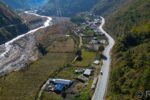The advent of modern nation-states imposed hard borders to protect the sovereignty and territorial integrity of each other.
But that also brought immeasurable miseries to the inhabitants of border areas by cutting and restricted their family and cultural roots and traditional trade routes.
In their new avatar, both India and China dictated the terms of engagement and connections on locals from a comfortable distance.
The domestic version of the hub and spoke system restricted the two identical entities to engage with each other freely.
The mutually inclusive Venn diagram was detached to construct two separate circles only to collide and suffused political, social, economic, and cultural suffering to the inhabitants of the region. Civilizations thrive on interactions.
An attempt to create an exclusive and restricted cultural identity brings no good but silently kills the knowledge gained from the interactions.
Imagine an invitation-only exclusive ancient ‘silk road club’ prohibiting different cultures to share knowledge and trade along the route. UNESCO must have found it difficult to enlist Mogao grottoes as a world heritage site. The Dunhuang spirit must continue.
Although, Indian and Chinese forces have disengaged from some clashing points in Ladakh and dialogue is still on to restore peace and tranquility in the region.
Given the unpredictable behavior and rising power-dilemma between India and China, the soldiers’ tanks and boots can return at any time to destroy the permafrost in the Himalayas.
The creation of joint local-civilian authority has the following advantages over border forces guarding the territory and carrying the infrastructural development in the border region.
However, to preserve the sanctity and serenity of the region, claimant of civilization state, India and China must give space to the Himalayan civilization to prosper by entrusting the local of Ladakh and Tibet region to move freely, trade, resume the lost family and culture connections.
Border -Trade and Tourism or Muscular Nationalism
As the disengagement has started to temporarily create a demilitarized zone, it may be ably constructed as a zone of peace managed by locals for development, eco-tourism, community and border trade.
The hard border creates temporary peace. Any desire for sustainable and lasting peace lies in ensuring communities divided by an imaginary line must continue their age-old traditions of social, religious and economic interactions.
The tragedy of hard borders in this globalized world is that sea-faring traders of Gujrat are settled in Zhejiang in China and that of Guangdong in Haryana, but traders of the traditional land route of Ladakh and Tibet are being denied their traditional routes of trade.
Instead of emulating Wagah border muscular nationalism along the India-China border, the success of Nathula Border trade can be replicated and even further develop along the contested borders.
In an enabling environment, India and China explore to construct ‘Kailash Mansarovar Corridor’ for pilgrimage via Leh-Demchuk route fulfilling the goals of Ladakh 2025 Vision Document instead of eyeballing on the heights of Kailash range. It takes 27 days to complete the yatra, trekking through rocks via Uttarakhand, which can be reduced to a few days.
Creating a soft border, among others, serves three purposes. Firstly, replace the encounters of patrolling soldiers with that of local inhabitants to strengthen the social connections, religious fraternity and economic inter-dependency.
Secondly, it acts as viable and sustainable confidence-building measures along the border away from media-hyped ‘managed’ military and political meetings to defuse the ‘created tension’.
Thirdly also reduces the inviolability of the border to threaten Westphalian sovereignty. The original architects of the Westphalian treaty are on the path to replicate the ancient Asian civilization model for the new century. Sadly, here we are emulating to construct a 17th century Westphalia to usher the peace in 21st century Asia.
From State Centric, Security Driven to Peoples’ Led, Community Development
With increasing infrastructural development and troops mobilization capability, friction spots along the border will rise proportionally.
Although the chances of any full-scale war are minimal given that both countries pose nuclear strike capabilities, interdependent nature of engagement, and unprofitability of war for both nations.
What is odd here is infrastructural and communications development along the border, instead of creating more avenues for constructive and profitable engagement for both the nations, endangers the security and peace in the region.
The problem lies in the objectives of the development. These developments for securing the border and protecting the territorial integrity threaten the lives and livelihood of the local inhabitants if tensions arise between two neighbors.
In addition, these military-grade constructions in the fragile Himalayas eco-system damage flora and fauna of the region.
From road construction induced Doklam standoff to the current violent Galwan clash, security-driven developmental work in the border region catalyzed and brought the two nuclear neighbors to the brink of military confrontation.
Thanks to mature leadership on both sides, confrontation is avoided but belligerent nationalist media, populist narrative and global political dynamics may challenge the fragile and hard-earned peace along the border more than ever.
To avoid frequent military transgressions and clashes along the contested border, the locals must be empowered to participate in the decision-making that affects their lives by not securitizing the development agenda instead of catering to local needs and sustainable development practices.
Ardent admirers of Mahabharata and Art of War must not let Chakravarti’ and ‘tinaxia’ collide but ensure overlapping to synergize tangible benefits for the region and beyond.
For this purpose, both countries must promote the establishment of joint local-civilian led authority to oversee the conservation, promotion of eco-tourism and sustainable developmental work in overlapping contested territory.
The creation of joint local-civilian authority has the following advantages over border forces guarding the territory and carrying the infrastructural development in the border region.
Firstly, unlike migrant soldiers, locals are the inalienable stakeholders and part of the social and cultural settings of the region. Secondly, people on both sides of the border share common aspirations of the cultural and social bond, while border forces of both countries lack any common bond.
Locals are united in common heritage and identity; the states draw the lines to divides them and soldiers protect the imaginary line.
Thirdly, if empowered to manage the contested land, civilian authority minimizes the chances of two forces encountering each other.
Fourthly, as inhabitants are acclimatized to the local climate and way of life, the defense budget can be used for providing basic necessities and developing eco-friendly infrastructure.
Fifth, the success of civilian authority to jointly manage the contested territory, till both countries settle the border issues, can set a precedent for conflict resolution and, most importantly, significantly increase the mutual trust between the two neighbors.
But having said that, it’s entirely up to the leadership of the two countries to trust their own people, which they claim to protect from another, to secure and manage their home. India and China have to learn to cohabit in the Himalayas.
Ardent admirers of Mahabharata and Art of War must not let Chakravarti’ and ‘Tianxia’ collide but ensure overlapping to synergize tangible benefits for the region and beyond.
(Rajiv Ranjan specializes in Chinese Studies and teaches international politics at Shanghai University, China. He is also an adjunct fellow at the Institute of Chinese Studies, New Delhi)









Comment